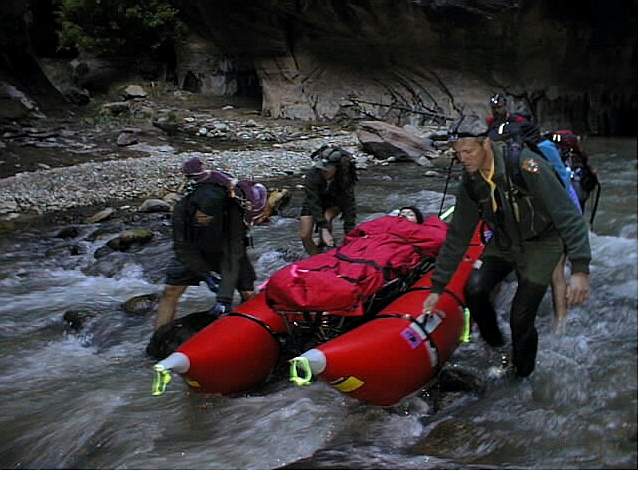 |
|
|
Zion National Park Rescue Craft Note the handle placements. Four rescuers can walk beside the victim while he is strapped to the stokes litter. The Stokes is strapped onto cat's frame system. When the water gets too shallow to float, the rescuers simply carry the boat and the victim. Any amount of water can act as a lubricant on PVC. Therefore it doesn't take much water to be able to move this boat down stream. Even with a double bottom the whole boat and frame weigh only 50 lbs, so it is light enough for 4 people to transport on thier backs including the Stokes Litter. As with all catarafts, it is easy to straddle rocks in the river. In this way evacuation can happen with the least amount of stress to the victim. 3D Concept Drawing with the Stokes Litter on Top Comments of Ray O'Niel Head ranger after the first use of "EDDY" the boat we made for them to rescue injured people from Zion National Park Narrows: Jack, We had our first Narrows carryout of the season yesterday which means that we had our first use of the rescue boat that you built for us. Our first patient had the last name of Eddy which gave us a great name for the boat. It worked extremely well. Our old rescue boat was an Avon 8 footer with a solid floor. The Eddy was very manueverable. We used to use seven people to move the Avon down the river. It was easier to move the Eddy with five people than the old Avon with seven. The Eddy is also lighter, more stable, and kept the patient drier than the old Avon. And, conditions were not ideal yesterday. The river is at record low levels, and the patient weighed around 200 pounds. The Eddy slid right over all of the exposed rocks. So, thanks for building us an excellent rescue boat. Here are the pictures
Wilderness Aware Rescue Culebra Have a look at the Solid Works design drawing. If you would like to see the 3D model of this. Download Solid Works Edrawings after reading this information. This is how the Wilderness Aware folks were able to verify design issues via email. Email me and I will send you this file to view with edrawings. After a person pulls himself into the mesh platform, they can get out of the cold water by sitting on the cross tube like this. See an actual rescue in a short video on YouTube. Here is what Jack Gunkle of Wilderness Aware has to say about the boat. I’m just settling back into the office after a month on the Salt. It’s not that easy to sit down in front of the computer all day after 4 five days! Anyway, I just wanted to thank you again for working on this boat with us. The final product is pretty much exactly what I envisioned. From the moment I took it out of the bag it’s been getting much attention. Some of our guides and I have taken it out on the Salt and tested it. Everyone really likes it and I haven’t really found anything I would change. The only modification I have done is to add locking carabiners to the cam straps that attach the adjustable floor. It just makes switching from the up to down position a little quicker. The dropped floor does create a little drag, but I don’t see any way around that and it’s very minor anyway. Here are a couple pics I was able to get. There not the best quality, but I will have more soon. Our photographer down on the Salt has more and as soon as he forwards them to me I will send them your way. We are having our oar frame built right now. As soon as that’s done I will get pictures of that too. My goal is to get good pictures of the entire process of scooping a swimmer out of the water. Remember if you want to have a fantastic spring river adventure, we highly recommend the Salt River in Arizona with Wilderness Aware. Have a look at the latest version of the Clear Creek Rescue Culebra This may look the same as the wilderness aware culebra, but it uses a bungie cord placed inside a special foam covered pvc pipe that is wraped in fabric. This bungie cord keeps the mesh floor in the up position untill a swimmer pulls it down and enters the boat. It may seem like a small detail, but it is difficult to build, and Clear creek will have some good feed back for us at the end of this first ultra high water year. To learn more about the kind of water that Clear Creek runs, see them on the web here.
Ultimate Hot Pack Hypothermia Devices The Wilderness IV Warmer utilizes the Hot Pack technology to HEAT IV fluids to help reduce the effects of hypothermia and shock. Complete with insulated IV tubing cover, two chemical packs, and full instructions. PVC/Nylon Reinforced bladder is unconditionally guaranteed. Raise the ambient temperature of a 1000 cc IV 40° F in 15 minutes. Great on the scene and in transit. Search and Rescue Culebra Riverboat Works Rescue Culebra Frame Therefore we are reasonably confident in this design. The rescue frame concept will be tested through out 2007 at various locations in the USA by swift water rescue teams. The rescue culebra with rowing frame and with out a rowing frame has been tested in 2004 through 2006. Please email me if you would like more information about the rescue culebra. My email address is on the bottom of each page in this web site. Consider contacting Ron Ferris at River Boat Works if you are interested in the frame or the transome concept depicted here. How Tube and Frame Designs Come Together Outfitter Rescue Culebra Looking at this picture one sees the relative positions of the parts. There is a fabric floor that goes more than half way up the middle. On the edge of the fabric floor there is an inflatable “foot thwart” for stability and to give paddlers a place to lock in their feet if necessary. (More foot thwarts can be added if necessary. The standard Outfitter culebra has 3.) There is a drop stitch floor with handles in the middle that is suspended above the water while the craft is in the whitewater position, (including low head dam rescue) and is easily lowered to provide a spot where a victim can self rescue, or it can be used as a dive platform. Note that there are d rings on the inside of the front and back that point toward the end. This allows the boat to be lowered easily to the water off of a bridge abutment. This craft can be customized to fit individual rescue needs. If you are interested in seeing more detail, the ability to zoom in out, and rotate this model, please go to this site, and read about edrawings, then email me and I will send you an edrawing file of the latest versions of this craft. Look at the actual boat from the front toward the drop stitch floor while it is suspended. Motorized Resuce Culebra Have a look at the drop down platform, the forward facing D rings, and how the strap and cross tube works to make a air frame system. Have a look at the Solid Works Design drawing here. If you would like to see the 3D model of this. Download Solid Works Edrawings after reading this information. Edrawings are how the King County folks were able to verify design issues via email. You can zoom in to minute details, rotate the model in 3D, and remove and inspect the various components. Email me and I will send you this file to view with edrawings. |
Order inquiries: shop.jpwinc@gmail.com © 2011 Jack's Plastic Welding, Inc
|
|


